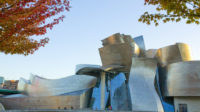Kimbell Art Museum and Guggenheim Bilbao Celebrate Anniversaries

This year marks the 50th anniversary of Louis Kahn’s Kimbell Art Museum, which opened in Fort Worth in 1972, and the 25th for Frank Gehry’s Guggenheim Bilbao, which opened in Spain in 1997. The 25 years that separate the two monuments mark a deep philosophical shift in architecture, from Kahn’s long interest in the idea of eternal architectural truths (many originating in ancient Mediterranean cultures) to Gehry’s inspiration in contemporary art (which he found in Venice, California, just down the road from his office). Kahn could not have seen the shift coming, and Gehry has never looked back: one vision didn’t grow out of the other. The shift was abrupt.
The two museums represent a fork in the road. Despite the cavernous gap that separates both design approaches, however, visitors across the decades have appreciated each as a compelling version of the “delight” that Vitruvius called for in architecture, along with “firmness” and “commodity.”
During the quarter century between their openings, Kahn’s closed, Euclidean design—calm, composed, symmetrical, modular, tracing to an archaic architectural tradition—gave way to Gehry’s chaotic architectural splash on the banks of Bilbao’s Nervion River. The Guggenheim’s relentlessly differentiated forms churned into an eruption of titanium, completely unexpected for a civic building. Extreme architecture from the avant-garde suddenly took center stage and pivoted expectations from the gravitas of civic monumentality, embodied in the Kimbell, to an ungridded, irregular monumentality of movement and dynamism.

Gehry’s tumultuous Guggenheim Bilbao. Photo courtesy Maremagnum / the Image Bank Unreleased via Getty Images, click to enlarge.
Kahn’s well-tempered masterpiece, its geometries based in Platonic solids, perpetuates Bramante’s knowledge of how to construct space with measure and regularity. Bounded by straight, planar walls and springing vaults, space in the Kimbell is contained, deliberately proportioned, and serene. An ordered sequence of galleries guides visitors subtly; the quietude encourages the contemplation that the artworks deserve. Kahn’s thinking is logical, linear, and respectful.
Designed in a period in which the computer revealed that there was order in chaos, the organic forms of Gehry’s Guggenheim, on the other hand, ultimately derive from his fascination with motion and fish (long story) rather than history, geometry books, and perspective. Guided by artistic intuition and an eye searching for energy in form, Gehry designed a gestural structure akin to the action paintings of Franz Kline and Jackson Pollock, canvases that keep the eye moving across their surfaces.
Gehry’s action design even resonated on the movie screen. The James Bond thriller The World is Not Enough (1999) opened with an aerial view of the instantly famous museum. Gehry had stepped on the gas pedal and built speed in space, an architecture of cinematic jump cuts, long shots, and about-turns that roil the building’s exterior.
Each of the two buildings represents a different form of beauty, but the visions also differ down to their respective physics. In the paradigm shift, the solidity of Kahn’s structure, with its vaulted roofs, is ultimately accountable to classical Roman stone architecture. Gehry’s titanium-clad design liquefies under the Spanish sun, transforming the building into a geyser of mercury. It lives in the changing natural light, whereas Kahn’s travertine and concrete, topped by matte lead roofs, sponges light, looking all the more timeless and immutable because of the solid geometries. Gehry’s building lives in and for the moment; Kahn’s, for eternity.
Kahn grouped his modular vaulted structures in rows, yet he interrupted the geometric regularity, constructing interventions such as wood paneling for the bookshop and partial walls for exhibitions. Gehry’s building, on the other hand, belongs as much to the natural forms of Bilbao’s collar of surrounding hills and mountains and the changing cloudscape as it does to the adjacent streetscape. It virtually swims along the riverfront.
For all their profound differences, there are profound similarities. Kahn organized the museum in a perfectly symmetrical C, wrapping the entry court, echoing the forum of Roman cities, while Gehry’s tumultuous design is actually organized like a classical Beaux-Arts structure, with three wings of galleries branching off a central atrium. The two buildings also exhibit interior clarity. Most of the approximately 20 galleries in the Guggenheim Bilbao are as orthogonal as the galleries in the Kimbell. Visitors need no ball of string to navigate the space.
Kahn, who simplified the architectural problem by designing a single-story building, with a basement for the auditorium, offices, services, and more galleries, handles light masterfully by splitting the cycloid vaults—which are wide in proportion to their height —lengthwise with linear skylights that spill light onto diffusers that bounce it off the vaulted ceilings: the interiors glow. “Light is the theme,” he said, sounding oracular, as always. Gehry, working in a three-story building, masterfully directs sunlight down from skylights through spacious chimneys that bounce light off the tall, wide flues leading to the gallery floors. In both buildings, galleries bask in an ambient luminosity that shifts with the changing light temperature of the day.
Despite the large galleries in each building, their spaces have a simultaneous grandeur and intimacy, because the architects design rooms, both real and virtual. Most of the galleries in the Guggenheim are box-shaped in plan. At the Kimbell, the line of the vaults projects virtual divisions to the floor. Vertically, Kahn’s vaulting ceiling brings levity to the spaces, while Gehry lifts the lid from his rooms, with chimneys that curve up to the skylights.
Each architect embodies his design with a strong materiality—Kahn with marble and concrete inside and out that confer a sense of weight and solidity, and Gehry, with titanium cladding, whose very nature is its ability to dissolve mass.
Perhaps because of their commonalities, the experience of seeing art in both buildings is surprisingly similar. Kahn hushes the environment with calming horizontals, the visual quiet enhanced by the overall geometric stability and the mass of stone and concrete. Like an author who captures readers from the first page, Kahn immediately establishes an ethos that lets visitors feel they are entering an almost sacred precinct, a treasure house. In Bilbao, the architectural spectacle creates a sense of expectation that follows the visitor inside. It’s a sleight of hand: the galleries are actually far more conventional and calm than the exterior implies.
In their different ways, both architects mystify the experience of being there, lifting visitors out of everyday mundanity into a frame of mind that conditions them psychologically for the simple act of standing in front of an artwork.
Museums are, by their nature, introverted, but each architect addresses his site urbanistically. Kahn responds to the parklike setting of the flat, open landscape in Fort Worth by casting his building in a bipartite, dumbbell scheme of galleries connected by a hyphen: the entry court gathers visitors from the big Texas landscape and embraces them into the museum. Gehry respects the surrounding city, extending its arteries and connecting his sprawling, freestanding building to Bilbao’s urban context by establishing a paseo that loops from the adjacent boulevard around the entire building, belting it into the cityscape.
The second context for both buildings, however, is internal: each architect builds off the collections. The Kimbell’s is largely historical, with a strong trove of European masters, many painted under the long influence of the Renaissance: Kahn mirrors naturalistic perspectival space in the paintings in his building. Architecturally, however, Kahn is a Modernist: he designed a modular, industrially repetitive ensemble.
If the Kimbell, then, is planimetric, extruded, and simple, Gehry’s Guggenheim is complex in section, and fully spatialized almost to the point of being wild in the Z dimension. Gehry’s implicit artistic mandate was to respond to the Guggenheim’s collection of art, which originally started as a selection of nonobjective work. Heavy on Kandinsky’s four-dimensional spaces, from the Guggenheim flagship in New York, the collection now includes contemporary works, such as Richard Serra’s twisting Cor-Ten Torqued Ellipses. Gehry’s architecture is ultimately grounded in the artistic revolution initiated by Futurists, Cubists, and Constructivists, and so there is agreement between the complex spatiality of early 20th-century paintings that broke down perspectival order and Gehry’s turbulent, white-water forms that launch the eye in a self-perpetuating movement of fragmentation and gesture. No center or axis stops the gaze. Architecturally, Gehry eschews the systems logic of Modernism in favor of an intuitive, nonlinear rationale that removes design from regulating systems of control, such as the grid, box, and perspective. In Gehry’s paradigm, structure is no longer determinant but subordinate to the imperatives of fluid form and space. Neither structure nor plan is the generator: image is the generator.
If the Kimbell is an ensemble embedded in the systems logic of the period, the Guggenheim is postindustrial and digital, made of fragments that deny any ideal of unity. Inevitably, each of these paradigms appeals to different sensibilities without being either right or wrong. Different forms of architectural imagination, each belongs to its period while exceeding the normative of its time. The Kimbell is a force of civilization emerging from centuries of architectural evolution: it elicits our respect. The Guggenheim is more a force of nature: inexplicable, it provokes wonder.
Gehry’s Vesuvian structure, so strong as an image, rode globalized information networks to massive international fame as an icon and social phenomenon. His design anticipated a new architectural context, the Internet, where so many buildings now are seen and only virtually experienced. Kahn’s monument was perhaps too quiet to attract and sustain the glare of media and remains an icon of the cognoscenti. It never surfed the web.
Each, however, is a masterpiece of its time that paradoxically transcends its time, anchored to a period despite the timelessness. Of course the zeitgeist, inevitably, changes, and perhaps in another 25 years, paradigms will shift again in ways we can’t yet anticipate. But in the next generation, the Kimbell and the Guggenheim will still inspire, each for its own individual reasons, and we will celebrate their next big birthdays with the same sense of respect and wonder that they have already provoked and earned for decades.


